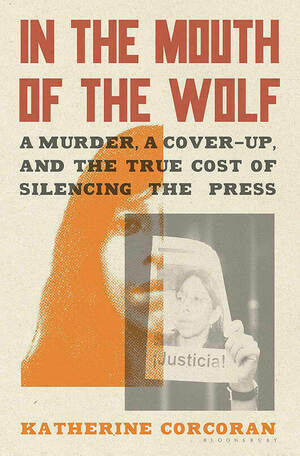While much of the news about Mexico that we see in American sources today revolves around seemingly intractable border troubles or bloody battles involving drug cartels, Katherine Corcoran’s new book, In the Mouth of the Wolf, trains a spotlight on a crisis deserving much greater attention than it has yet received.
In the past decade, according to the Paris-based nonprofit Reporters Without Borders, 85 journalists have been killed in Mexico — 14 already this year — with more than 150 murdered there since 2000. Except for war zones, Mexico is the world’s most dangerous country for newspeople.

A 1981 Notre Dame alumna, Corcoran investigates the brutal slaying of one reporter, Regina Martínez, to portray the human dimension behind the frightening statistics. Through careful reporting and rigorous research, Corcoran reveals the complex interactions among politicians, drug lords and journalists.
Crime and corruption are intertwined to such a degree that someone trying to untangle all the lines connecting the world of politics and the illicit underworld runs the risk of becoming the target of a hit job. That’s what happened to Martínez on April 28, 2012.
During much of this past decade, Corcoran, a reporter in Mexico for nearly a decade and the Mexico City bureau chief of the Associated Press from 2010 to 2015, devoted years to examining the Martínez murder. Several chapters about Mexico’s history and its contemporary realities reflect Corcoran’s 2017-18 fellowship at Notre Dame’s Kellogg Institute for International Studies.
In recreating Martínez’s life and career, Corcoran presents the upside-down predicament that exists in a society where contacting the police for help can lead to more trouble, and the military often acts in partnership with drug cartels to mutual advantage.
The government goes so far as to fabricate stories — authorities claimed the Martínez killing was a crime of passion, for instance — and then to bribe government-friendly newspeople to spread the falsehoods. Early in her book, Corcoran asserts: “A society without truth is a scary place to live.” Each subsequent page proves that point.
Corcoran draws on the scholarly studies of Notre Dame political scientist Guillermo Trejo to explain Mexico’s “criminal governance,” which unites public figures and the brazen lawless in what Trejo considers an “ecosystem of coercion, corruption, and criminality.” To call the country “a scary place” almost qualifies as understatement.
First for a local newspaper in the state of Veracruz and then for a national magazine based in Mexico City, Martínez specialized in unearthing civic malfeasance, particularly the untold billions of pesos that government officials received illegally. In this inverted environment, public servants are transformed into masters of power and wealth, often in collusion with gangster types willing to pay handsomely for the government’s protection and other necessary amenities.
Despite the danger she faced daily, Martínez kept reporting. Tracking the flagrant misuse of funds was one dimension. She also investigated the thousands of people who “disappeared” and the mass graves that became their final resting places. Her compass for seeking social justice always pointed in the direction of exposing actions that took advantage of the poor and the indigenous groups.
Married to her work and the ideal of a free press in Mexico, Martínez spent her weekends alone to concentrate on major stories without interruption. There’s no shortage of journalistic heroism in the meticulous portrayal rendered here.
What makes In the Mouth of the Wolf riveting nonfiction are Corcoran’s vivid development of the narrative and the way the different pieces of this puzzling murder-mystery fit together. Deftly integrated historical and sociological context broadens the scope of the investigation, while Martínez remains at the center of the overall story.
The book is divided into three parts. The first describes the complexities of the killing, the second details Martínez’s accomplishments as a journalist and the third recounts Corcoran’s own resolute reporting to find out everything she could about her subject.
This last portion of the book, the longest of the three, stands out as a personal chronicle of how to unravel a perplexing story: the endless interviewing, the close scrutiny of articles by and about Martínez, the frequent frustrations of arriving at dead ends, the uncertainty of forming seemingly reasonable judgments, and all the rest. The section could stand alone as required reading for students considering careers in journalism.
To her credit, Corcoran admits mistakes as she gathers facts and background, adding at one point that she had become “extremely paranoid.” Later, when a key source clams up and refuses to talk, Corcoran wonders: “Why was he withholding information from me? We all started to doubt one another. It was the power of paranoia.”
Throughout this last section, numerous motivations for Martínez’s murder receive treatment — with the government the principal suspect. But who specifically and why? Did one article trigger the assassination, or was it a reaction to several exposés?
Within this detailed case study, Corcoran raises weightier issues. At the outset, she argues that an independent press is vital to “the preservation of democracy,” whether in Mexico or in the United States.
The baseless charge that journalism is “the enemy of the people” is ludicrous, but it is dangerous, too, when it leads to violence directed at newspeople, as it has so tragically south of the American border.
In the Mouth of the Wolf is a sobering, thought-provoking book that proves without doubt the bravery of two women: Regina Martínez and Katherine Corcoran. The fundamental cause of free, ethical and public-spirited journalism animates the heart — and the soul — of their work.
Robert Schmuhl is the Walter H. Annenberg-Edmund P. Joyce Professor Emeritus of American Studies and Journalism at Notre Dame. The new, expanded edition of his book, The Glory and the Burden: The American Presidency from the New Deal to the Present, was just published by Notre Dame Press.